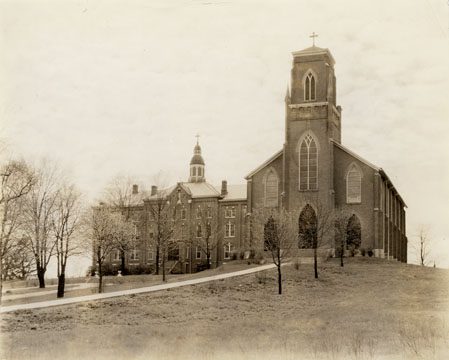Logan Ohio Churches: A Guide to Local Places of Worship
Logan Ohio Churches: A Guide to Local Places of Worship
Blog Article
Checking Out Historical and Modern Churches for All Faiths
The exploration of modern-day and historic churches acts as an extensive lens whereby we can take a look at the development of faith and community dynamics throughout cultures. From the intricate designs of ancient sanctuaries to the minimalist appearances of contemporary prayer spaces, these frameworks encapsulate the significance of their time and place. They are not just areas of prayer; they are representations of social values and cumulative aspirations. As we take into consideration the relevance of these sacred sites, one must consider exactly how they continue to shape interfaith discussion and neighborhood involvement in today's varied globe.
Building Designs With the Ages
As architectural expressions of spirituality, churches have actually evolved considerably over the centuries, reflecting the varied doctrinal and cultural influences of their times - Logan Ohio Churches. The building styles of churches are as differed as the idea systems they stand for, each design symbolizing specific churches and neighborhood worths
Early Christian style emerged from Roman basilicas, identified by basic, longitudinal structures including a nave and aisles. As the Middle Ages proceeded, Gothic design held, marked by sharp arcs, ribbed safes, and flying buttresses, which permitted for larger discolored glass windows that lit up insides with magnificent light. The Renaissance duration brought a revival of timeless aspects, emphasizing percentage and symmetry, while Baroque design introduced sophisticated information and remarkable forms, embodying the grandeur of spirituality.
In the 19th and 20th centuries, the surge of various movements, such as Arts and Crafts and Innovation, reflected societal modifications and a separation from conventional kinds. Today, contemporary churches typically blend modern products and ingenious designs, embracing sustainability and neighborhood engagement. This rich tapestry of building designs illustrates the ongoing dialogue in between belief and design, showcasing just how churches remain to adapt to the spiritual demands of varied populations around the world.
Famous Historic Churches

One more impressive instance is the Notre-Dame Basilica in Paris, commemorated for its French Gothic style. Its detailed appearance and sensational tarnished glass home windows reflect centuries of commitment and creativity, making it a symbol of both confidence and resilience, particularly after its current restoration adhering to the devastating fire in 2019.
In the Americas, the historical Mission San Juan Capistrano in The golden state showcases Spanish colonial style, highlighting the early Catholic objectives that played an essential role in the area's cultural development.

In Addition, the Hagia Sophia in Istanbul, originally built as a cathedral, represents a blend of Christian and Islamic heritage, showcasing the abundant tapestry of history that churches commonly symbolize. Each of these historical churches not just functions as an area of worship but additionally as a cultural site, preserving the stories of varied areas across time.
Modern Church Innovations
Modern churches are progressively embracing cutting-edge layouts and innovations to improve the praise experience and foster area engagement. These technologies materialize in numerous types, from architectural advancements to digital integration. Numerous modern churches feature open, flexible rooms that can be conveniently reconfigured to fit diverse tasks, such as solutions, celebrations, and curricula.
Integrating innovation is critical in modern church design. Top notch audio-visual systems, live streaming capabilities, and interactive screens allow members to link not only within their walls however additionally with a more comprehensive target market online. This digital outreach has actually ended up being crucial for preserving neighborhood connections, especially in an era where numerous individuals look for spiritual links beyond typical settings.
Sustainable design practices additionally play an essential role in modern-day church developments. Lots of institutions are going with eco-friendly materials and sustainable energy resources, showing a commitment to environmental stewardship that reverberates with congregants.
In addition, the combination of art and imagination right into praise spaces, through installments, multimedia, and murals presentations, serves to enhance the spiritual ambience, making the experience more immersive. These innovations collectively mirror a shift in the direction of a more dynamic and comprehensive approach to praise and area life.
Area Impact of Churches
Churches play a vital role fit and uplifting neighborhoods, commonly tipping up to resolve neighborhood demands and obstacles. Past their spiritual features, these establishments regularly participate in social outreach and give crucial solutions that cultivate area communication. Lots of churches operate food banks, shelters, and counseling services, dealing with issues such as poverty, being homeless, and psychological health and wellness.
Additionally, churches commonly work as event places for area events, helping with dialogue and unity amongst diverse groups. By organizing academic programs, workshops, and cultural events, they motivate personal development and cumulative empowerment. Their interaction in neighborhood advocacy initiatives intensifies the voices of marginalized areas, adding to social justice campaigns.
Additionally, churches usually work together with local companies, improving their influence via partnerships that combine sources and know-how. This interconnectedness strengthens area ties and advertises a sense of belonging amongst residents.
Essentially, churches are not merely areas of prayer; they are integral to the social textile of their areas. Their diverse contributions-- spiritual support, social services, and area activism-- play a crucial role in promoting resilience and favorable change within culture.
Checking Out Churches Around the World
When discovering the varied landscapes of spirituality, visiting churches around the world offers a special home window into the artistic and cultural expressions of confidence. Each church acts as a testament to the background and worths of the community it represents, mirroring architectural styles and regional practices.
From Home Page the splendour of St - Logan Ohio Churches. Peter's Basilica in Vatican City to the minimal beauty get more of Tokyo's St. Mary's Sanctuary, these sacred areas personify an abundant tapestry of human experience. The intricate discolored glass of Chartres Basilica in France narrates biblical stories, while the lively murals of the Ethiopian Orthodox churches portray the nation's distinctive spiritual heritage
In addition to showcasing creative mastery, churches often serve as centers of area and social engagement, organizing occasions that reinforce bonds amongst congregants. Many likewise use possibilities for interfaith discussion, advertising understanding and respect among different belief systems.
Taking a trip to these churches permits site visitors to appreciate the universal styles of hope, love, and empathy that transcend social barriers. Whether one understands a certain confidence or otherwise, the experience of going to these spiritual websites enhances our understanding of the human mission for significance and connection.
Final Thought

The expedition of historic and modern churches serves as an extensive lens via which we can examine the evolution of belief and community dynamics throughout societies. Today, modern churches usually blend ingenious styles and contemporary products, welcoming sustainability and area interaction.Throughout background, many churches have actually emerged as famous landmarks, each telling a special story of area, creativity, and confidence.Modern churches are significantly accepting innovative styles and technologies to improve the worship experience and foster area interaction.Additionally, churches often offer as event places for neighborhood events, facilitating discussion and unity among varied groups.
Report this page